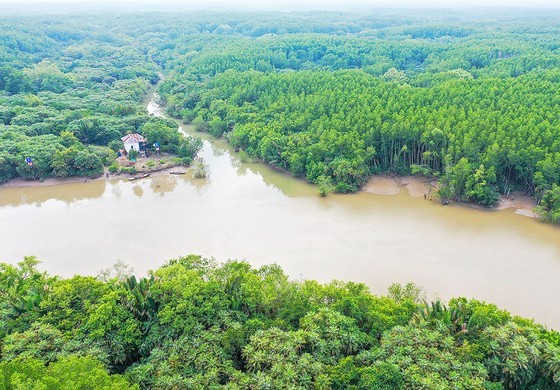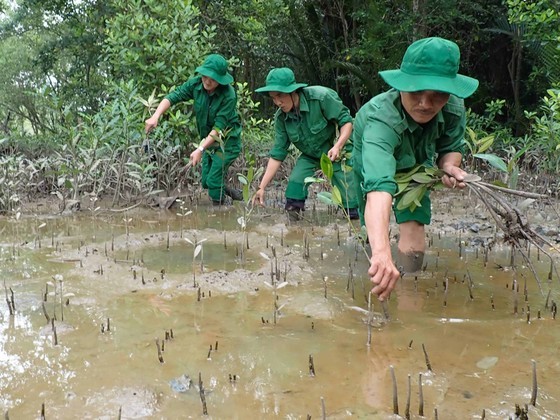Ho Chi Minh City is also promoting cooperation with the World Bank to implement the program ‘A low-carbon city development’ with the orientation to participate in the carbon market.

Can Gio Biosphere Reserve
Over the past time, the southern largest city has prepared steps to guide business establishments to develop emission reduction plans at the request of the Government.
The Law on Environmental Protection 2020 stipulated the development of the domestic carbon market, with an official operation roadmap from 2028. This is the latest legal basis for regulations on the organization and development of the carbon market.
The building and operation of a domestic carbon market will help Vietnam effectively reduce carbon emissions, and increase compatibility with international carbon pricing mechanisms; plus, the Southeast Asian country will have opportunities to link with the carbon market in the world and in the region.
The carbon market is a resource generation mechanism through the purchase and sale of carbon credits to promote the development and application of low-emission technologies toward a carbon-neutral economy.
In Ho Chi Minh City, KMDK Company (Korea) has worked with Ho Chi Minh City to implement the project of trading targets to reduce greenhouse gas emissions at the Dong Thanh landfill in Hoc Mon outlying district since 2010. This mechanism is implemented in the form that instead of conducting emission reduction projects in their own countries, developed countries can help developing countries reduce greenhouse gas emissions. The volume of emissions reduced from this cooperation is included in the emission reduction target of that developed country.
In contrast, developed countries pay an amount to developing countries upon an agreement. According to this plan, KMDK Company will implement a project to reduce emissions and pay Ho Chi Minh City about US$3 million. Due to the financial difficulties of KMDK Company, the project was not implemented. However, the investment in emission reduction at landfills in the southern metropolis is still considered to have great potential in emission reduction activities.
According to Assoc. Prof. Dr. Phung Chi Sy, Vice President of the Vietnam Association for the Protection of Nature and Environment, the field of land use, land use purpose change and forestry field have the potential to reduce emissions by up to 9.3 million tons of CO2.
In addition, afforestation projects, projects under the clean development mechanism, or nationally appropriate climate change mitigation actions (NAMAs) also have the potential to generate carbon credits for attracting investors.

Vietnamese activists are planting trees in Can Gio
Forest carbon credits, reduction of greenhouse gas emissions through the fight against deforestation and forest degradation, and sustainable management of forest resources are being seen as new resources for Vietnam in general and HCMC's Can Gio District particularly. The mangrove area in Can Gio Biosphere Reserve has a total area of 75,740ha and it is divided into three parts including the 4,721ha core, the 29,880ha transitional area and the 41,139ha buffer zone has great potential if it participates in carbon credit exchange.
According to preliminary calculations of Mr. Bui Nguyen The Kiet from the Protective Forest Management Board of Can Gio district, the Can Gio mangrove forest can absorb nearly 11 million tons of CO2 per ha and provide about 8 million tons of O2 per ha; accumulates about 3 million tons of CO2/ha and has a CO2 exchange value of about $77 million a ha a year.
At the United Nations Climate Change Summit in 2021 (COP26), Vietnam made a strong commitment that it will reduce its net emissions to zero by 2050; the Government has issued Decree 06/2022 on reducing emissions and light greenhouse gas emissions and protect the ozone layer; plus, it has also issued the Decision 01/2022/QD-TTg on the list of industries, sub-industries and establishments that must check how much they produced greenhouse gas.
Vietnamese government issued these decrees to manifest its dogged determination in reducing greenhouse gases. However, in order to operate the carbon market, in the context that there is not much time to implement international commitments, the country is facing huge technical challenges.
According to Assoc. Prof. Dr. Nguyen Hong Quan, Director of the Research and Development Institute of Circular Economy of Vietnam National University, in order to promote the development of the carbon market, Ho Chi Minh City needs to have a specific study and assessment of the carbon market potential that fields can deploy for carbon capture; for example, Can Gio forest, agricultural activities, and waste treatment.
After the overall study and assessment, priority areas must be identified to call for cooperation in implementation. Support mechanisms and policies also need to be based on the potential of each project group to be issued accordingly. Ho Chi Minh City can also ask the Government for a specific mechanism to develop a carbon market. With its potential, HCMC can not only sell but also buy carbon credits in other countries.
Businesses need to grasp information and carefully prepare to join the special market through capacity building in greenhouse gas inventory activities. In summary, local state management agencies need to promote awareness-raising activities so that establishments and enterprises develop technology for participation as well as complete policies to support and encourage enterprises to participate in the domestic carbon market. The State needs to fully issue regulations on activities to connect and exchange domestic carbon credits with regional and global carbon markets.
At the seminar on "Low-carbon development" recently organized by the Department of Natural Resources and Environment of Ho Chi Minh City in collaboration with the World Bank, Vice Chairman of the People's Committee of Ho Chi Minh City Vo Van Hoan informed that there are 140 large establishments in the city which have been operating in the fields of energy, construction, industry and trade; thus, the city needs to check how much they produced greenhouse gases according to Decision 01/2022/QD-TTg.
The low-carbon urban plan in HCMC includes activities, recommendations and action proposals needed to achieve HCMC's development goal of low carbon emissions. This can be considered a very good signal for Ho Chi Minh City in the field of environmental protection in 2023.
By Minh Hai – Translated by Anh Quan